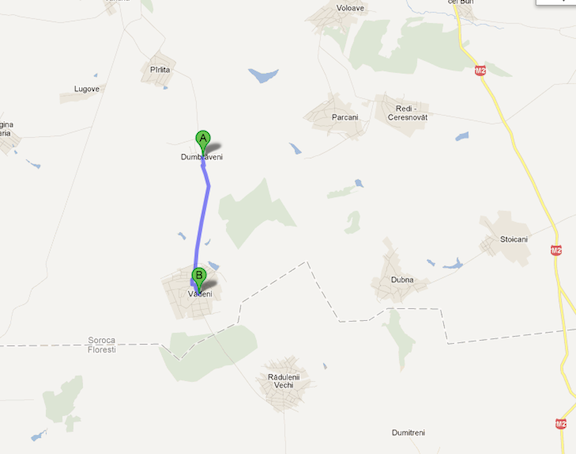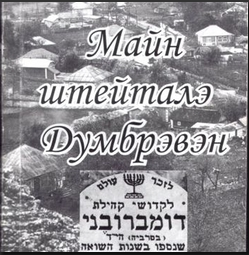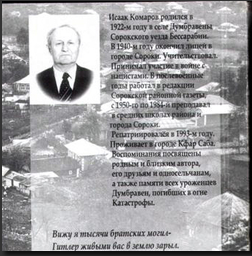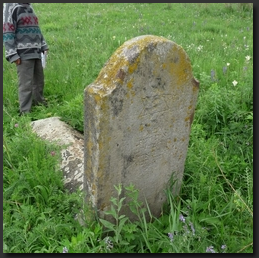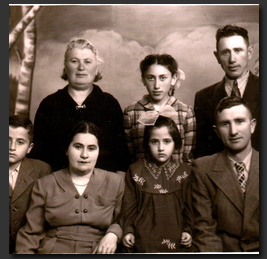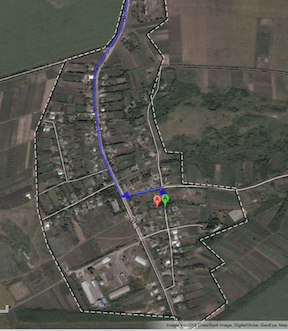"Dombroven" (Yiddish)
"Dombroven", "Dombroveni", "Dombrovani", "Dumbraveni, "Dumbraveny", "Dumbrăveni Keinar"
Lat: 48.0505561828613281° N, Long: 28.2280559539794922° E, elevation 700 ft.(234 m) above sea level
The timezone in Dumbraveni is Europe/Chisinau

David Gilboau (Israel) visiting the village shows location of Dumbraveni on map. May 2010
For years this place changed its name a couple of times. Dombroven in yiddish, Dumbraveni in romanian, Dumbraveny in russian. Dumbraveni name also exist as a large town in Romania today. Dumbraveni is a town in the north of Sibiu County, in the centre of Transylvania, central Romania. The town lies on the banks of the Tarnava Mare River, 20 km east from the city of Medias, the second largest city in the county. Do not be confused with the name Dubravitza. Its a similar sound name of a village in Balti district area of Moldova. The place that we are talking about was always called Dombroven, Soroki uezd (district) in Bessarabia. If you would have a chance to research Yad Vashem testimonies you are able to find a lot of places that are mentioned as Dombroven, Romania. In general, that is a right statement (Dombroven, Bessarabia was under control of Romania from 1918 to June 1940). While doing research for your family roots its always helpful to check with the list of family names used to live in Dombroven. That will help you to avoid the confusion with the people of large Dumbraveni city from Romania.
On June 2000 Dr. Arnold Davidson (USA) answering a question about Dumbraveni wrote next message that was placed at JewishGen site:
The Dumbroveni you are referring to was generally known in Yiddish as Dombroven. It was in the district/county/Judete of Soroki in the region of Bessarabia. It was 7-8 miles south-southwest of Soroca, the county seat of Soroki. Dombroven was the first Jewish agricultural village in Bessarabia.
It was founded by volunteer Jewish settlers in the early 1830s, who responded to a decree by Czar Nicolai I (ruled from 1825-1855), in which he granted immunity from military service for members of the immediate family and exemption from taxes and assessments for 10 years to any Jew who volunteered to settle and work the soil in Bessarabia. Bessarabia at that time had been recently acquired by Russia following the Russo-Turkish war of 1806-1812.
My great-great-grandfather (Rav Menachem Mendel DAVIDZOHN) was the first Rabbi of Dombroven and my great-grandfather (Rav Shmuel Wolf DAVIDZOHN) and grandfather (Sheftel DAVIDZOHN) were shochtim and interpreters of the law there.
Maps
Dumbraveni communities map today
Jewish Communities nearby:
Parcani (3 miles NNW); Frumusica (8 miles SW); Stoicani (6 miles SE); Pirlita (2.0 miles N); Cosauti (13 miles N); Marculeshti (13 miles NW); Soroca (10 miles NNE); Nimereuca (15 miles E); Vertiujeni (14 miles E); Alexandreni (19 miles SE); Zguritza (23 miles SSW); Yampol, Ukraine (14 miles N); Camenca (22 miles E); Balti (35 miles SW); Faleshti (53 miles SW); PicturesPhotos of Dumbraveni people (1900-1940)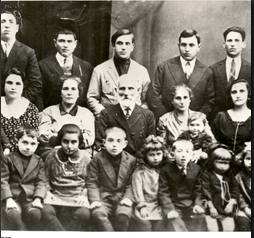
Background InformationFrom the Encyclopedia Judaica: Early Communal History Dumbraveni as a Jewish agricultural colony in Bessarabia was founded in 1836 on approx. 3,217 acres of land (1 acre=0.4 hectare) bought by 24 family settlers from Podolia. It developed the most advanced level of farm economy in the Jewish colonies in the region. 371 families (1,874 persons) were living there in 1899, according to census of 1924 population of Dumbraveni was 2,886 people. The Holocaust Period After occupation by the Soviet Army in June 1940, the rabbi and community leaders of Dombroveni were exiled to Siberia; Jewish property was confiscated in stages and all Zionist activity outlawed. In 1941, in the interval between the withdrawal of the Soviet forces and the entry of German-Romanian troops, Dombroveni was plundered by the inhabitants of the nearby villages, and the Jews fled to the outlying fields. When they were caught by the Romanian troops they were all concentrated in the school courtyard, robbed of their money and jewelry, and ordered to leave the place. Those who turned west were murdered by the Germans they met en route; others turned east and reached the Dniester, where some succeeded in crossing the river with the help of the remaining Soviet authorities and took refuge in the Soviet Union. Still others were caught by Romanians and dispatched to Transnistria, where they were either killed or died of starvation and disease. The settlement itself was leased out and all the property seized and distributed among local peasants.Courtesy of: "Encyclopedia Judaica". 1972, Keter Publishing House Jerusalem Ltd, Jerusalem, Israel Podolia is a large area across river Dnestr with the center of the district in Vinnitza, Ukraine.As the economic situation in the beginning of the 20 century has weaked, a lot of youngsters and young couples started to immigrate from Dumbraveni to Argentina, Brazil, Palestine and USA. On July, of ninety forty-one I left the nest with another twenty-two the same age guys and went to the county town Soroki, the draft board, where we called the front. We did not return to Dumbraveni, but all these years we have been inextricably linked to this native land ... On the spur of the Carpathians, on the edges of a broad valley called by locals Yar spreaded Dumbraveni shtetl. The first inhabitants of this place settled here as early as the eighteenth century, artisans and merchants of the Forty. Fast settling of Dumbraveni began after 1812, when Bessarabia was included in the Settlement of the Russian Empire. The official documents of the year 1836 recorded the transformation of this place into the Jewish agricultural colony. About a hundred families of the Transnistrian regions of Ukraine, including - from the famous shtetl Medzhybizh - the center of origin Hasidism came from. See Wikipedia for Medzhybizh. It is known that the decrees of Nicholas I-st facilitated the settlement of the Bessarabian region and helped to attract Jews to agricultural labor. They were given loans to purchase land, livestock, farm implements, temporarily freed farmers from the draft. The jews of Dumbraveni purchased a large plot from Princes Cantacuzenus living in Iass, Romania. In the seven mares of the same suit bartered for the site boyar Rousseau. Until now, the peasants of neighboring villages with Dumbraveni, Vantsyna, Pyrlitsa call this place the "shapte Iepe" - "seven mares." It was not easy for our ancestors to get used to the agricultural labor. My grandfather Hersh Fuchs (Zichron levraha - bright memory of him!) told me 70 years ago that not all settlers had the opportunity to purchase Agricultural machinery. Dash began before the arrival of the auditor. Jews have learned about it in advance. They rented Agricultural machinery for Moldovans from the neighboring villages and Parkany. In 1920-1930-th (my childhood and my youth!) the main occupation for the locals was farming: they grew wheat, corn, sunflower and soybean in an area of 2500 hectares. Large families had good income, they were engaged in a labor-intensive crop - tobacco. Large flocks of sheeps were owned by the families of Korenblit, Sorotskiy, Akselrud, Elgurt and others. Artisans and merchants were not less than 20% of the population of the village. Many of them were treated with small plots of land. We tried to sow seeds of an elite field. In winter time the manure from cows and horses were taken on the fields . Dimitshteyn, Weinberg and others planted seeds of sugar beet, carrots, onions, poppy's. Their products were shipped to Europe. The traders from distant America bought from us Astrakhan (treated skin). The colony had a small office that collected milk for sale. In exchange the villagers got butter and low-interest loans. In general, residents of Balti and Soroki were glad to buy kosher butter from Dumbraveni. Jews in the village made a healthy peasant way of life: getting up before dawn, going to bed early. In the agricultural season they "worked hard" all the daylight hours. Tobacco growers in the winter worked at nights, preparing products for shipment. Even in the late 40's, when drought gripped Moldova, working farm "Dumbraveni" still managed to get a small crop : at the end of the thirties (1930) the Jews have dropped hundreds of tons of fertilizer into this soil ... Youth Dumbravenies, with rare exception, warmly supported the Zionist movement. In the 20-30's in the shtetl was very active the organization "Gordonia". See Gordonia movement. Dozens of young men and women, who supported the movement have left then for mandatory Palestine. Halutzim of early 30's: Hona Fleischer, Zisman, Shterenberg, Manya Shleyzer - gathered us children and spoke about the Holy Land, Joseph Trumpeldor, Chaim Arlozorove and other fighters, practicing with us songs in Hebrew. [After the war in the 50-th the large Dumbraveni Synagogue for many years has been turned into a workshop for the repair of agricultural machinery.] In the colony, where the maximum number of Jews reached to the end of the nineteenth century 1,700 people, in the 1930 years of the twentieth century there were 5 synagogues, a large library with books in Yiddish, Hebrew, Romanian, Russian, an elementary school with instructions in Russian - to 1918, in Romanian - up to 1940. The village used to have a drama club, readers' conferences were held monthly,. Into the village used to come groups of actors (in particular, the troupe famous Sidi Tal). Our parents tried to give children not only religious education, but also a higher secular education. All children of school age ( from 7 years old) were involved in hederah and Talmud-torus schools. There are no jews in Dumbraveni who were illiterate. Romanian teachers used to get a job with competition in our elementary school. All jewish children regularly attended classes, have been neatly dressed. The best graduates continued their education in the Jewish public and private high schools in Romania The most important person in any shtetl XIX - early XX century was the local rabbi. Dumbravenies preserved the memory of Rabbis Moshe and Levi Shterenberg. Levi Shterenberg was a prominent personality among them not only in Dumbraven, but in the whole part of Bessarabia. He was Rabbi of Dumbraven for 31 year - from 1909 to 1940-th. He was born in Dumbraven in 1882 and died in exile in 1945, after living so far 63 years. As a child he lost a leg, however, he led a very sedentary life, was a true spiritual mentor, teacher and friend of the whole community. The doors of his large house were always open to believers and non-believers. He was a great Torah scholar, Jewish philosopher, historian and literature teacher. In his library were books in Hebrew, Yiddish and Russian. He studied medicine independently. Rabbi Levi Shterenberg was concerned not only about the people, he helped local organizations and institutions - banks, schools, economic development "shtetls". The rabbi was a counselor in the analysis of economic, family disputes. His intelligence, humor helped to reconcile the conflicting parties. Rabbi Shterenberg had seven children. All of them, except his smallest daughter, went to Mandatory Palestine in the 20's and 30's of the last century. Levi Shterenberg was a religious Zionist. He believed that Zionism would lead to the liberation of the Jewish people, and our ancient religion - Judaism - will keep us as a nation. Levi was one of the founders of the "Mizrahi" (an anagram of the term "Merkaz Rouhani" - "spiritual center", the word also has a direct value - 'East') in Bessarabia, was elected its chairman, delegate of the "Mizrahi" to the Twentieth Zionist Congress (Zurich , 1937 year). He loved Halutzim, who were building a new country at the Land of Israel, I wish all of them were expert in the Torah, the Jewish followers of tradition. Religious Zionists, by Rabbi Shterenberg, were the dominant force in the shtetl Dumbraven. He also spoke against the ultra-Orthodox from the organization "Aguddat Israel", worked in public funds: "KKL-JNF", "Keren Yesod." His speech to the Jewish towns and villages of Bessarabia always touched the hearts of listeners. After many passionate appeals to women, they took off their gold ornaments and handed them to the fund "Keren Yesod." On the money thus collected were purchased from the Land of Israel hundreds of dunams of land. Rabbi Levi Shterenberg often traveled to the central city of Romania at various conferences on Jewish issues. Returning to his native place, he talked about the work carried out, meetings and presentations. At his Shubbat speeches used to come Jews from all synagogues of the "shtetl". In 1927, he traveled to the Land of Israel. Rabbi admired the work of young people, saw all the difficulties, but he believed in the liberation of his people. Levi Shterenberg received a post "State rabbi of Dombroven" from his father. He was considered as very Tora knowledgeable person, he worked closely with Rabbi L. Tsirelson, the rabbi of Kishinev (1859-1941), and later the main rabbi of Bessarabia. He enjoyed great prestige from the people of Dombroven and other shtetls around. In 1940, he received a certificate that allowed him for going to Palestine, but he did not have time to go: June 28, 1940 in Bessarabia the date, when Soviet troops entered. Soon, he was arrested and placed into jail of Soroca. Only two months later, to date the russians allowed him to have an appointment with the youngest daughter Hadassah, who was then working with me in the village school Khristich Soroca district. With tears in her eyes, she described his appearance: he cut-off his beard (as it did with the Jews of Western Europe the Nazis!), He was very haggard and pale, deprived from shoelaces over legs. For the promotion of Zionism he was sentenced to six years in prison with deportation to Uzbekistan. MSSR Supreme Court at the request of the famous people decided to release Rabbi as a disabled. They were waiting for confirmation court order from Moscow. But on June 22, 1941 the war broke out. Haddasya has not found him in Soroca jail. She was told that her father was sent to the east. Overcoming great difficulties, she got to Uzbekistan. The Information Bureau of the republic did not know about him, but Hadassya left them her address. From prison father sent her a card. Correspondence exchange began. Levi Shterenberg complained about his health. It is known that shortly before his death, he was released from prison and sent to the city of Urgench, where he worked as an accountant. In 1944 Dumbraveni Jews who returned from the ghetto, received from him a farewell letter. They collected a thousand rubles, and sent to him. But the money was returned with a note: "The person does not exist". After the war it became known that Rabbi Levi Shterenberg died in 1945 in the city of Urgench. Local Jews had buried him at the Jewish cemetery with all our customs. Shortly after the war, Hadassah left for Palestine. She created a family here, but she died very young. Today in Israel live and work grandchildren, great grandchildren, great-grandson of the famous Rabbi from Dumbraven - Levi Shterenberg.
About the author of the book "My shtetele Dumbraven"The author of the book My shtetele Dumbroven Isaak Komarov was born in 1922 in Dumbroven village, district of Soroca, Bessarabia. At that time the whole Bessarabia area was under control of the Romanian government (capital Bucharest). On June 1940 Isaak graduated from Soroca High school. Up to July 1941 he taught in a school. At the beginning of the war on July 1941 he was recrutted into Russian Army. (On June 22nd 1940 Soviet Army eliberated Bessarabia and the territory became a part of Soviet Union). Komarov took active part in war battles against fashizm as a soldier of the Russian Army. He returned to Soroca after the war where he worked as an assistant editor of local newspaper. From 1950 up to 1984 he worked as a teacher of middle and high schools of Soroca district . In 1993 Isaak Komarov with his family and two married daughters immigrated to Israel. He lives in Kfar - Saba now. His book My shtetele Dumbraven is devoted to relatives and close friends, to dumbravenies who perished in Holocaust. Click on photo to enlarge.
Use Google translator. Type in URL on top www.google.com/translate. Copy and Paste the russian text into translator to read the article in english English translation at the JewishGen, Yizkor book site. You can support english translation of the book by donating to JewishGen, Yizkor books (Dumbraveni) Edited by: Chaim Toren. Published in Jerusalem, 1974 You can read original text on the web-site of the New-York Public Library (in Hebrew and Yiddish)English translation at the JewishGen, Yizkor book site. You can support english translation of the book by donating to JewishGen, Yizkor books (Dumbraveni) You can read original text on the web-site of the New-York Public Library (in Hebrew and Yiddish)Edited by: Chaim Toren. Published in Jerusalem, 1973 Published by Yad Vashem. Published in Jerusalem, 1980 Memoirs and Family Stories
Searchable DatabasesAdditional Categories of Information
Other Dumbraveni Links |
I would like to thank all people who participated in the Dumbraveni WebSite project. I hope that we will be able to add more interesting and related material, documents and photographs to the site. In the meantime I believe that our Dumbraveni site opens a window into a wide jewish research for our future generations, whos roots came out from Dombroven or who are interested in jewish heritage.
Please send comments, corrections, and suggestions for additions to Peter Seltser at pseltser@yahoo.com.
|
Copyright © 2013 Peter Seltser |
There have been visits to this page.
This site is hosted at no cost by JewishGen, Inc., the Home of Jewish Genealogy. If you have been aided in your research by this site and wish to further our mission of preserving our history for future generations, your JewishGen-erosity is greatly appreciated.


